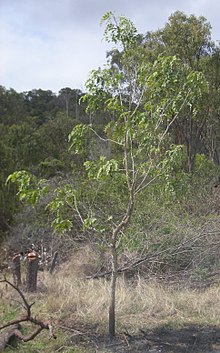Albizia canescens
| Belmont siris | |
|---|---|
 |
|
| Scientific classification | |
| Kingdom: | Plantae |
| (unranked): | Angiosperms |
| (unranked): | Eudicots |
| (unranked): | Rosids |
| Order: | Fabales |
| Family: | Fabaceae |
| Genus: | Albizia |
| Species: | A. canescens |
| Binomial name | |
|
Albizia canescens |
|
| Synonyms | |
|
Albizia plurijuga |
|
Albizia plurijuga
Albizia canescens, commonly known as Belmont siris, is a species of Albizia, endemic to Northern Australia.
While superficially similar to the closely related A. lebbek, which has an overlapping native range, A. canescens can be distinguished by several features. The crown of A. canescens is more open than that of A. lebbeck, and the foliage glaucous rather than dark green. Both the flowers and pods of A. canescens are small and inconspicuous compared to the showy, globular flowers and large pods of A. lebbeck, and the bark of A. canescens is fissured, corky and more fire resistant than the tessellated bark of A. lebbek..
The growth habit if the species is variable, with individuals able to persist and fruit as either a large single stemmed tree to 10 metres, or as a large multi-stemmed shrub. The shrub form appears to develop as a result of coppice regeneration following burning and enables the species to survive in the eucalypt savannas of Northern Australia which are subject to frequent fire.
Albizia canescens is endemic to Northern Australia in a belt from The Kimberley across the Top End to Rockhampton in Central Queensland. The species grows as a medium-sized tree scattered throughout eucalypt savannas. It is rarely abundant in any locale, though common on the CSIRO research station "Belmont" in Central Queensland, from whence it derives its common name. The species appears to have been more common in the past, and the apparent decline may be due to increased fire and browsing pressure from introduced herbivores
...
Wikipedia
